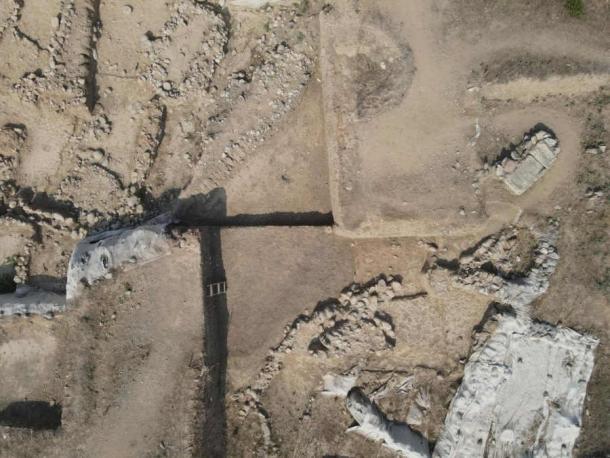🔴 Website 👉 https://u-s-news.com/
Telegram 👉 https://t.me/usnewscom_channel
During the archaeological excavations at Yeşilova Höyük Mound in Izmir’s Bornova district, a remarkable 8,200-year-old kohl applicator (AKA eye liner) made from stone was discovered. It is evidence of people being conscious of their appearance way back near what we know as the dawn of civilization.
Also significant is the dating of the recent finds, which pushes back the date of occupation of the location to around 8,500 years ago – roughly 6,500 BC. These excavations have uncovered important evidence of Neolithic Age life, providing insights into the culture and environment of the early Aegean settlers.
Unlike the closely packed houses of Çatalhöyük in central Anatolia, the people in this region lived in separate homes with distinct roofing systems, reveals Arkeonews.
Examining the Mound: A Sharp Pencil, Women’s Self-Care
The Yeşilova Mound excavation, which has been ongoing since 2005, is supported by Türkiye’s Culture and Tourism Ministry, İzmir Metropolitan Municipality, Bornova Municipality, and Ege University. Archaeologists are also working at the nearby Yassıtepe Mound, and the findings from both sites are shedding light on historical settlements in the Izmir area.
Yeşilova Höyük is a mound in the Bornova district of İzmir, Turkey, and is the oldest known prehistoric human settlement in the area of İzmir. (DHA)
Zafer Derin, the excavation leader from Ege University, announced that the stone kohl applicator, measuring 9.5 centimeters (3.75 inches) in length, is the oldest of its kind ever found.
The tool, sharpened like a pencil, was used by dipping it into a container of paint to apply cosmetics, a practice still seen in parts of Anatolia today. The discovery adds to previous evidence of Aegean women’s interest in beauty and self-care, including ornamental vessels found in the region dating back 4,000 years, reports Sondakika.
Prof. Dr. Zafer Derin with the 8,200-year-old kohl applicator. (DHA)
The black residue on the tip of the kohl applicator has been sent for analysis, but is believed to be manganese oxide, a powdered mineral that served as the key ingredient in kohl, an ancient cosmetic used as eyeliner. This find is significant not only because it is the oldest kohl applicator ever discovered, but it also suggests that people in this region cared about their appearance, placing an emphasis on enhancing their eyes—a feature often highlighted in ancient beauty practices.
Excavation Head Assoc. Prof. Dr. Zafer Derin said:
“There is a black paint residue at the tip of the find. These are called kohl. It is an ornamental tool. This shows that Aegean women 8,200 years ago also cared about their ornaments, were fond of their beauty and took care of themselves.”
Beauty Standards in Ancient Izmir: A Delicate Practice
Other artifacts from the same region reinforce this notion. Archaeologists have uncovered ornamental vessels, indicating that women stored jewelry and personal adornments. These items, found in abundance at Yeşilova and Yassıtepe mounds, suggest that personal grooming and beauty were important aspects of life.
The evidence of personal adornment goes beyond practical items like kohl applicators. Archaeologists have discovered beads, necklaces, and bracelets made from a variety of materials, including bone, stone, and seashells, which were likely worn as jewelry.
The use of seashells indicates the importance of the Aegean coast and its resources to the people of the region. These shells were either traded or collected, revealing early networks of exchange and interaction among coastal and inland communities. The labor and effort required to gather or trade these materials reflects a high degree of value. Jewelry made from these items was not only a form of personal beautification but also a reflection of cultural connections to the natural world and the surrounding environment, along with social status.
Personal Space
The discovery of separate houses in the Aegean Neolithic settlements, as opposed to the closely packed dwellings of Çatalhöyük, might suggest a higher degree of privacy and individual domestic life. This separation could have allowed for more personal space, potentially giving women the opportunity to focus on personal grooming and beauty rituals.
Burial customs in Neolithic societies also show that grave goods, including jewelry and personal ornaments, were sometimes buried with the deceased, supporting the idea that beauty and adornment were not only important in life but also carried symbolic significance in death.
All of this evidence clearly hints at a culture where women took pride in their appearance, much like women in later periods. The fact that these traditions span thousands of years reflects the continuity of self-care and beauty practices in the region.
Top image: Left; Female eye made up with kohl. Right; kohl applicator found at Yeşilova Höyük Mound in Izmir’s Bornova district, Türkiye. Source: Left; gmstockstudio/Adobe Stock, Right; DHL
By Sahir Pandey


